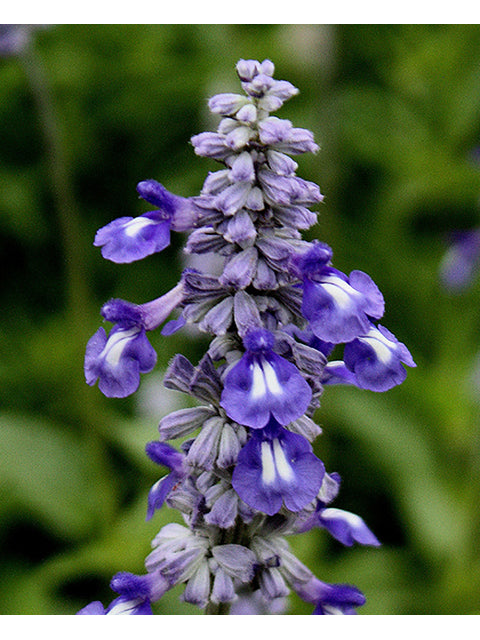Mealy Blue Sage 'Henry Duelberg' (Salvia farinacea 'Henry Duelberg')
Mealy Blue Sage 'Henry Duelberg' (Salvia farinacea 'Henry Duelberg')
11 in stock
Couldn't load pickup availability
Salvia farinacea Benth.
Mealy Blue Sage, Mealy Sage, Mealycup Sage
Lamiaceae (Mint Family)
Synonym(s): Salvia earlei, Salvia farinacea var. farinacea, Salvia farinacea var. latifolia
USDA Symbol: SAFA2
This 2-3 ft. upright or sprawling perennial, usually forms a mound as wide as the plant is tall. Mealy Sage is named for the mealy-white (sometimes purple) appearance of the sepals, which are covered with felted hairs. The blue flowers are 5-lobed and 2-lipped, 2/3-3/4 inch long, with 2 stamens and 1 pistil. They have the usual sage fragrance. The long, narrow leaves grow in clusters, out of which grow the flower stems. The leaves may or may not have teeth. Dark-blue to white, tubular flowers are densely congested in whorls along the upper stems, creating a 3-9 in. spike. Gray-green, lance-shaped leaves are numerous, especially in the lower portion of the plant.
Plant Characteristics
Bloom Time: Apr , May , Jun , Jul , Aug , Sep , Oct
Distribution
USA: CT , FL , LA , NM , OH , OK , TXNative Distribution: C. & w. TX & NM
Native Habitat: Prairie, Plains, Meadows, Pastures, Savannas, Woodlands' edge, Opening, Dry calcalreous substrates
Growing Conditions
Water Use: LowLight Requirement: Sun
Soil Moisture: Moist
Soil pH: Acidic (pH<6.8)
Soil Description: Limestone soils. Calcareous, Limestone-based, Caliche type, Sandy, Sandy Loam, Medium Loam, Clay Loam, Clay.
Conditions Comments: Mealy blue sage grows well in perennial borders and wildflower meadows. The foliage is aromatic and deer resistant. When new basal foliage appears, cut the old flower stems to keep the plants lush. Will bloom off and on throughout the summer. Butterflies and hummingbirds enjoy the nectar. Mealy blue sage provides an attractive mass of color in beds, borders and naturalized areas. Wet soil will make the plant leggy and weak.
Benefit
Use Ornamental: It is an excellent plant for a flower bed, and is often planted in groupings to create an attractive mass of color. The leaves have a grayish cast which make a good contrast to lush green foliage of other plants. It is a good plant for a rock garden. Showy, Blooms ornamental, Mass planting, Perennial garden.Use Wildlife: Nectar-Hummingbirds, Nectar-Bees
Conspicuous Flowers: yes
Fragrant Flowers: yes
Fragrant Foliage: yes
Attracts: Butterflies , Hummingbirds
Nectar Source: yes
Deer Resistant: High
Value to Beneficial Insects
Special Value to Native BeesThis information was provided by the Pollinator Program at The Xerces Society for Invertebrate Conservation.
https://www.wildflower.org/plants/result.php?id_plant=SAFA2
Image Information
Photographer: Smith, R.W.City: Austin
County: Travis
State: TX
Location Notes: Lady Bird Johnson Wildflower Center.
Accession date: 2023-01-10
Filename: RWS_IMG3490.JPG
Slide Index: 4722E-Salvia farinacea.JPG
Restrictions: Unrestricted
Collection: Wildflower Center Digital Library
Original Format: Digital
Orientation: Portrait
Shot: Close-up of flowers in a raceme.
Date Taken: 2022-04-17
NPIN Image Id: 90308


